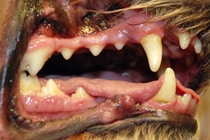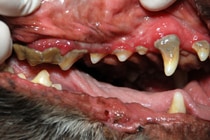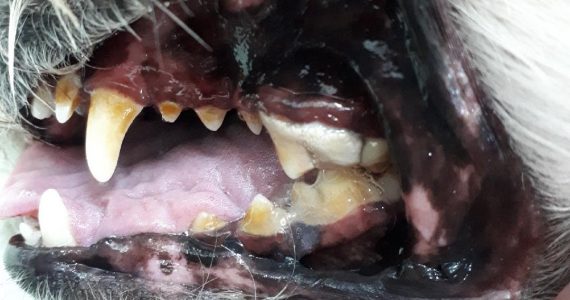Dental Disease – what to look for and what to do.
Dental Disease
Can you imagine how your teeth would look and feel if you didn’t brush regularly, or at all? Tartar would build up on the visible surfaces of your teeth and potentially extend below the gum line causing gum infection or gingivitis. The infection would spread to the root and bony socket, causing periodontal dental disease.
The same process can affect cats and dogs, 80% of dogs and cats over the age of three years have some sort of dental disease, which worsens with age. This can be a real problem for pets because it can lead to more serious issues, as dental infections can spread to the heart, liver and kidneys via the bloodstream causing illnesses in these vital organs.
Signs of teeth issues to look out for in cats and dogs include:
- Bad breath
- Red and inflamed gums
- Stained teeth
- Your pet may also start dropping food when they are eating.
There are 4 grades of dental disease, ranging from O (healthy teeth) through to 4 (severely diseased). The images below give you visual guide of these grades:


Grade 1 dental disease Grade 2 dental disease


Grade 3 dental disease Grade 4 dental disease
Dental checks are an important part of your pet’s annual health assessment and are an ideal opportunity for owners to find out if their pet has an existing problem that has gone unnoticed.
It is recommended to check your pet’s teeth regularly as they often won’t show pain associated with their mouth. Even pets with sore gums, an infected mouth or broken teeth will continue to eat so you may not notice they have any problems.
However, when a pet opens its mouth, only some parts of the gum and teeth are visible. This makes the full extent of the dental disease difficult to identify. As a result your veterinarian may recommend investigating your pet’s dental health further, under general anaesthesia. This allows for a thorough dental investigation of every single tooth, above and below the gum line, and in most cases will include dental x-rays to get a picture of what is happening to the bone and tooth roots.
Regular (ideally daily) tooth brushing is the gold standard in home dental care. Tooth brushing is safer and more effective than chewing and many dogs and cats can be trained to enjoy having their teeth brushed, especially if started when they’re young.
Although bones are a popular treat that you may be using for dental care, they can cause problems such as broken teeth and gut obstructions.
A summary of signs of dental disease in your pet:
- Persistent bad breath
- Red, bleeding, swollen, receding or eroding gums
- Yellow-brown plaque or tartar on the teeth
- Loose, infected or missing teeth
If in doubt give us a call and we will be more than happy to assist you in assessing your pets dental health.

